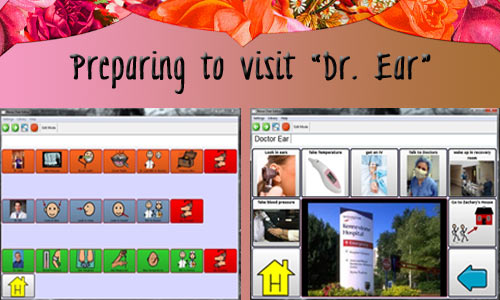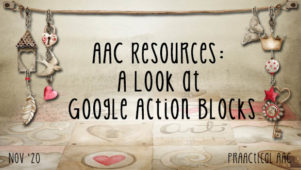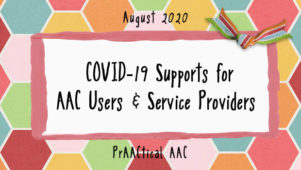A PrAACtical Look: AAC at Dynamic Therapy Associates
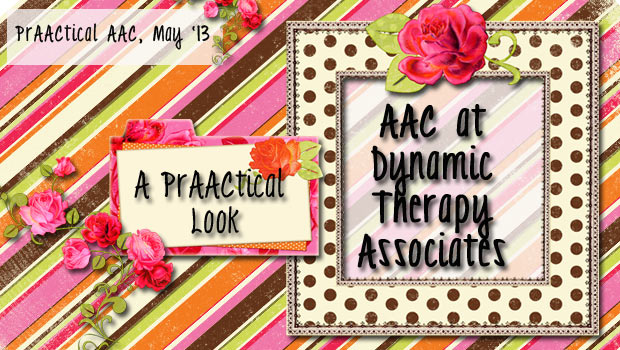
We’re so excited to continue our PrAACtical Look series with a guest post from Vicki Clarke, who is the CEO of Dynamic Therapy Associates, a speech language therapy clinic in Kennesaw, Georgia. Vicki specializes in AAC, conducting local and national device evaluations, consultations, treatments and trainings for individuals, clinics, school systems and  professional organizations and manufacturers. Vicki has a wealth of knowledge in the prAACtical aspect of AAC service provision and shares a tiny bit of that with us in this post about preparing clients who use AAC for medical encounters.
professional organizations and manufacturers. Vicki has a wealth of knowledge in the prAACtical aspect of AAC service provision and shares a tiny bit of that with us in this post about preparing clients who use AAC for medical encounters.
::::::::::::::::::::::::::::::::::::::::::::::::::::::::::::::::::::::::::::::::::::::::::::::::::::
I was asked to contribute a “favorite therapy activity” kind of post to this blog a few months ago. Decisions, decisions, decisions….I love Arts & Crafts Therapy, Cooking Therapy, iPad Therapy, Shopping Therapy, and Hang-Around-And-Chat Therapy but what to share? I mulled it over and I decided on “Serious Medical Procedure Preparation Therapy.” Fun stuff, right?!!?
We do a lot of good work in therapy sessions with our patients but what I hope to highlight today is the significance of the work we all do in modifying devices to meet our patients’ complex, and changing needs. I believe firmly that our support for families and well thought out modifications are as important as the actual face-to-face work we do with our young friends. Speech generating devices can be “translators” for some of our friends. These talking boxes translate what patients see into words they hear. Speaking boxes allow our friends to use their pictures to talk and translate this visual language into something their family and friends can understand. Today we are talking about helping our patients understand language and then discuss the really BIG stuff in their lives.
I have the fortune of working with my patients for a very long time. I’m serious, as in 15 or more years for some of them. I’ve wiped their snotty noses and hugged them through minor illness and distresses since they were 3 and 4 years old. Lately several of these friends of mine have had significant medical situations arise, a need for a CT Scan, VNS battery replacement surgery, onset of diabetes, reconstructive inner ear surgery, to name a few. These friends of mine have a variety of diagnoses such as autism, chromosome deletion syndrome, cerebral palsy, developmental delays, and mitochondrial disease. They are all functionally nonverbal, communicating with speech generating devices. Most of my friends have small comfort zones: places, activities and people with whom they are comfortable. As you can imagine this rarely includes hospitals, CT’s and doctors.
For me the answer is often TECHNOLOGY, so why not for this problem as well? The route we took was using our communication devices to introduce these new places, procedures and people in a safe, familiar manner before the big events. The devices were loaded with pictures, videos and slideshows our young people could explore at their leisure, when they were calm and in familiar environments. On the big day, the devices moved with their owners from their homes, into their cars and vans and helped them transition to their medical appointments. Maestros and NovaChats joined their owners in waiting rooms, on wheelchairs and in hospital beds. Step by step our young people touched pictures of procedures, watched snippets of videos and allowed their blood pressure to be taken, blood to be drawn, IVs set in place and a lengthy CT Scan to be completed: nothing short of a miracle for all of these teenagers. Ears were repaired, VNS batteries replaced and cancer ruled out! These young people left a sea of nurses, doctors and their parents with dropping jaws as they calmly navigated waters where they previously struggled. Instead of nervously handling our children, doctors and nurses went out of their way to come into their rooms to see what they had to say.
“How are you supposed to put into words the significance of this? It’s ‘ginormous!’ For the first decade or so we didn’t go to the doctor unless it was something significant. You only went to the doctor as a last resort, if we couldn’t fix it ourselves. Now (Zachary) goes and has physicals and regular checkups with the ENT to make sure everything is okay. I don’t have to wait until he has the 105 degree fevers, seizures and raging infections before we have it checked out. Preventative medicine is now an option.” Shari Willingham, Zach’s Mom
So here’s how you do it!
Add photos of medical procedures, generic doctors/nurses, facility building & rooms
- All of our devices allow you to put a photo on a button. The easy answer to this dilemma is to simply take pictures of each medical procedure, the facility and generic doctors/nurses all dressed in their uniforms. Since it’s not always practical to actually take these pictures yourself, we supplemented personal pictures with images we saved from Google searches.
- Organize the photos on the devices. We organize based on what we know makes sense to the individual client. Zachary actually helped label, arrange and color code his pictures on his NovaChat. He chose to put each doctor’s pictures on one row, labeled the doctor “Dr. Ear,” (ENT) “Dr. Lisa,” and “Dr. Head” (Psychiatrist) and gave each their own color row. For Zachary, it made sense that this page was placed under the category of “People” on his “Doctor” page. Dr. Ear got his own special page since the event was a major surgery.
Some of our friends understand visual scenes (context based communication) so these pictures live in their scene pages. Their parents and I created their pages for them.
Use the advanced features of the devices to give even more information to our friends.
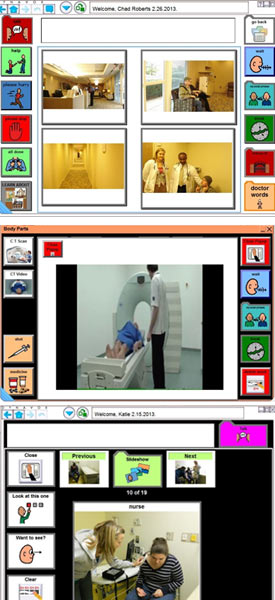 Our friend Chad required a CT Scan, 15 minutes of lying completely still, in a tube with clanking and buzzing sounds all around him. To help him understand this concept, we introduced a video we downloaded off the internet which gave a thorough visual walk through of the event.
Our friend Chad required a CT Scan, 15 minutes of lying completely still, in a tube with clanking and buzzing sounds all around him. To help him understand this concept, we introduced a video we downloaded off the internet which gave a thorough visual walk through of the event.
Katie’s Maestro has slide shows which she uses for “Learn About It.” Her doctor pages were incorporated into her device in this familiar format. She can select to watch the slide show of pictures or simple page through her images. Each image has a verbal explanation and personally relevant image.
So what does this have to do with expressive communication? Each of our patients used their devices to understand what was happening to their bodies. The response in the hospital and doctor’s offices was overwhelmingly positive. Chad’s mother, Kellie reports that his doctors now talk TO him when he comes in. They no longer talk exclusively to his mother ABOUT him. Chad tells all his doctors “do not put a band-aid on me,” and they don’t. Katie’s nurses move slower and explain themselves much more clearly to her before touching her. After the fact, all of our patients look back over their pictures with their families and friends. They have the ability to share their experiences and a place to go when they feel sick again and need to talk about it.
None of this could have occurred without active and engaged families…now how do you think THAT impacts communication?
Filed under: PrAACtical Thinking
Tagged With: device customization, Dynamic Therapy Associates, Medical, patient care, SGD programmming, Vicki Clarke
This post was written by Carole Zangari
